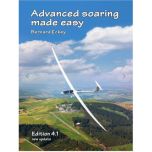Improving Cross-Country Decisions

When we are flying cross-country, the picture as we look ahead is packed with potentially useful information to help us decide where to point the glider.
While a fat cumulus cloud lying bang on track might seem the obvious place to go, that will not always be the best decision. If a hard right avoids that beautiful well developed cloud, but takes you to a cloud street that runs for 100km and arcs back onto track, which option would you choose?
What this means is that we need to make decisions on two levels. Short-term decisions based on the weather immediately ahead, we also require a long-term strategy. Let’s have a look at how short- and long-term decision making might come into play when we’re going places, cross country, or racing a competition flight.
Short-term decisions
Always have a short-term plan. Knowledge of the wind direction will help you locate lift under clouds, and help you decide whether a ridge will work. Remember to constantly monitor the wind strength and direction: it may alter due to a change in the weather (perhaps an approaching front) or terrain (bending as it funnels up a valley). An example of a good short-term plan would be: “I’ll go to the upwind side of the cloud ahead, then I’ll try the two beyond it. If they don’t work I’ll try soaring the ridge facing into the wind, and if that doesn’t work I’ll land in the good area of fields at the bottom.” Always try to plan a few steps ahead. It is always a worry when your last option doesn’t work out and you’re left with nothing but a “think bubble”!
Follow the best line of energy, seems obvious, but many don’t do this. When thermal soaring, try and ‘join up the dots’ to weave under the best lift whilst still moving forwards. Continually re-evaluate your decisions. Important, watch the clouds carefully. I try to use a “freeze-frame photography” technique, taking regular snapshots in my mind of the sky ahead to see how it’s developing. There is no point pressing on to a decaying CU just because it looked good ten minutes ago when you were in a decision-making mood…
Key point, do not make a final decision until you have to. Sometimes, when you look at two clouds a reasonable way ahead you really can’t decide which looks the best. It sometimes pays to point between them both, whilst you closely monitor options. Only commit to one when you’re sure it’s the better choice or you just have to make a decision.
Long term decisions
Get a feel for the day from the forecast approaching fronts or expected thunderstorms should make you think of starting earlier rather than later. The forecast also gives an idea of an appropriate task to set. Work out your expected cross-country speed, a conservative estimate of the day’s duration, and hence a good distance to fly. In competitions with a fixed distance, your speed estimate tells you the approximate time required. Consequently, you can work out what start time enables you to fly in the best part of the day.
Change gear when conditions change. One of the absolute keys to cross-country flying is to spot when the weather is deteriorating ahead, so as to climb high in the last respectable thermals. Similarly, when you see a marked improvement ahead it’s critical to saving time by pushing into the better weather.
Work out the day’s puzzle. Before you start, and on task, try to closely monitor all the factors outlined above, and piece them together to solve the puzzle...
Banner photo taken by fotorama.co.nz









